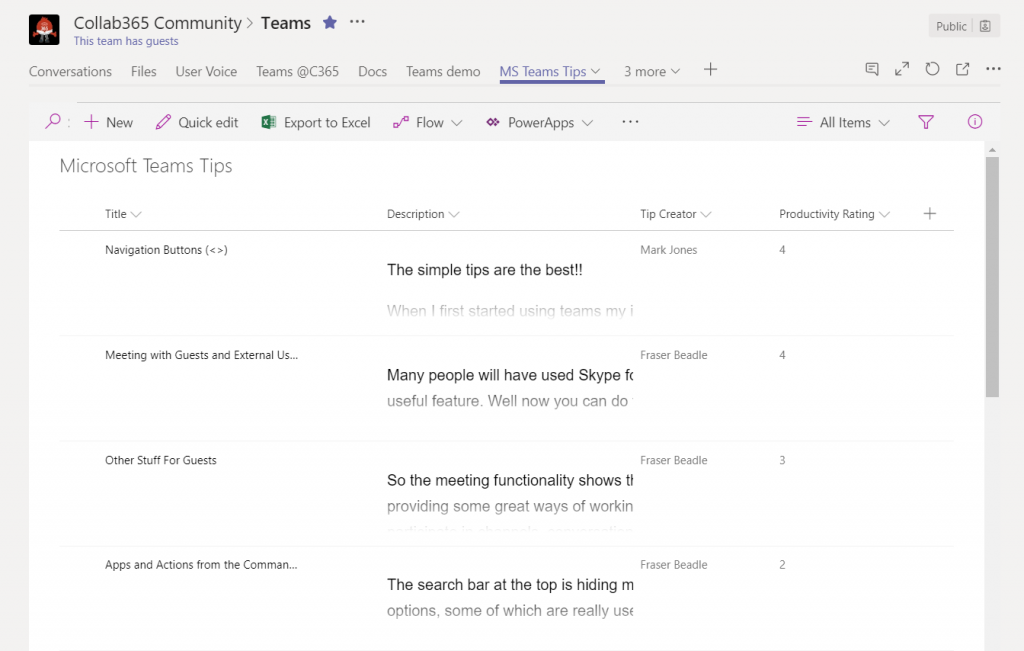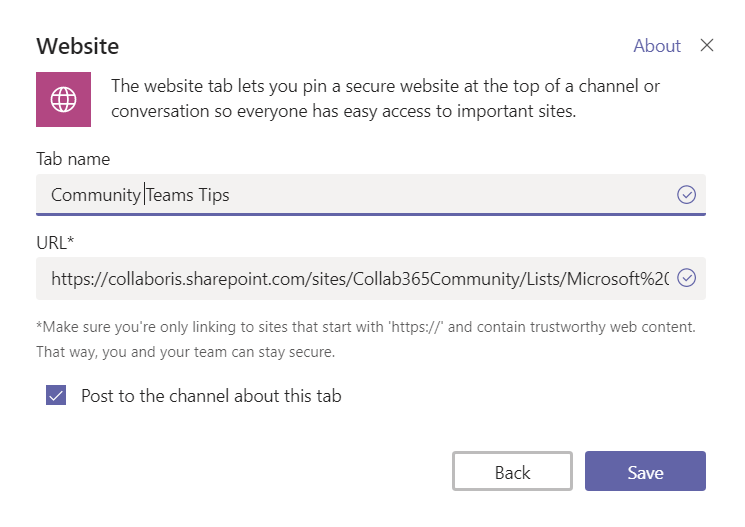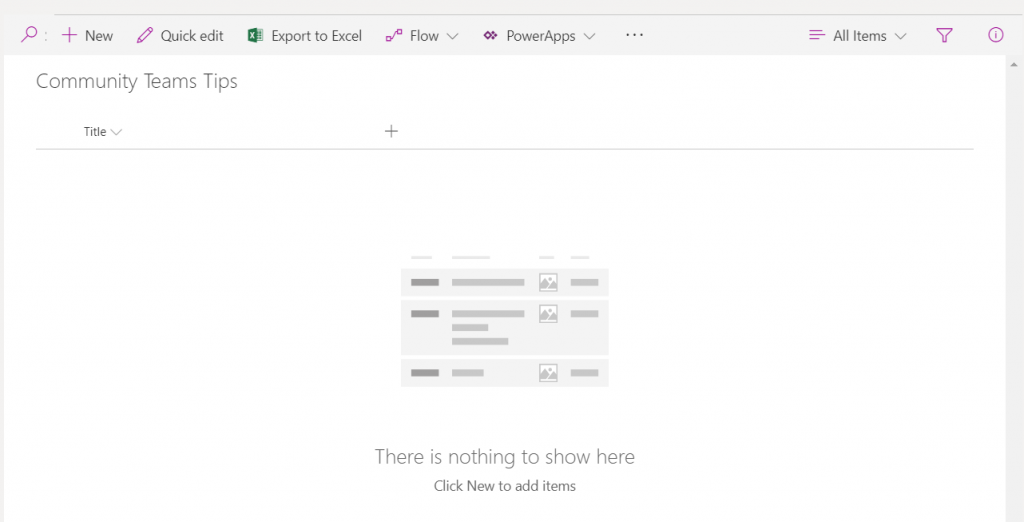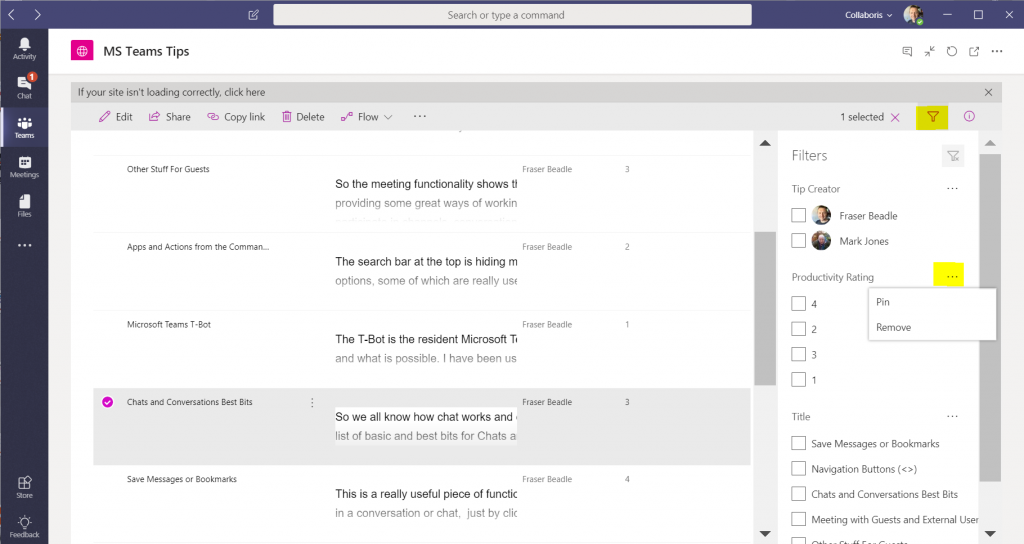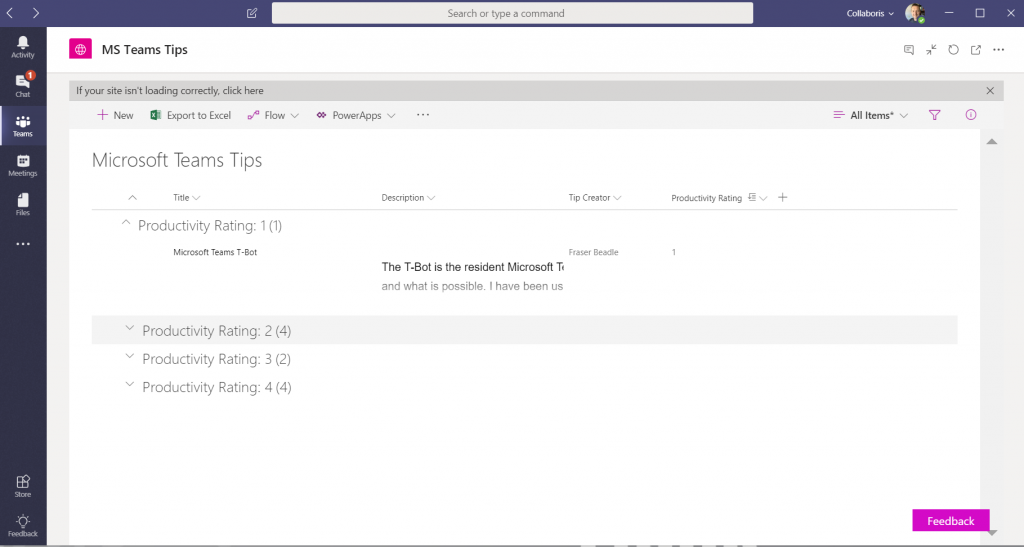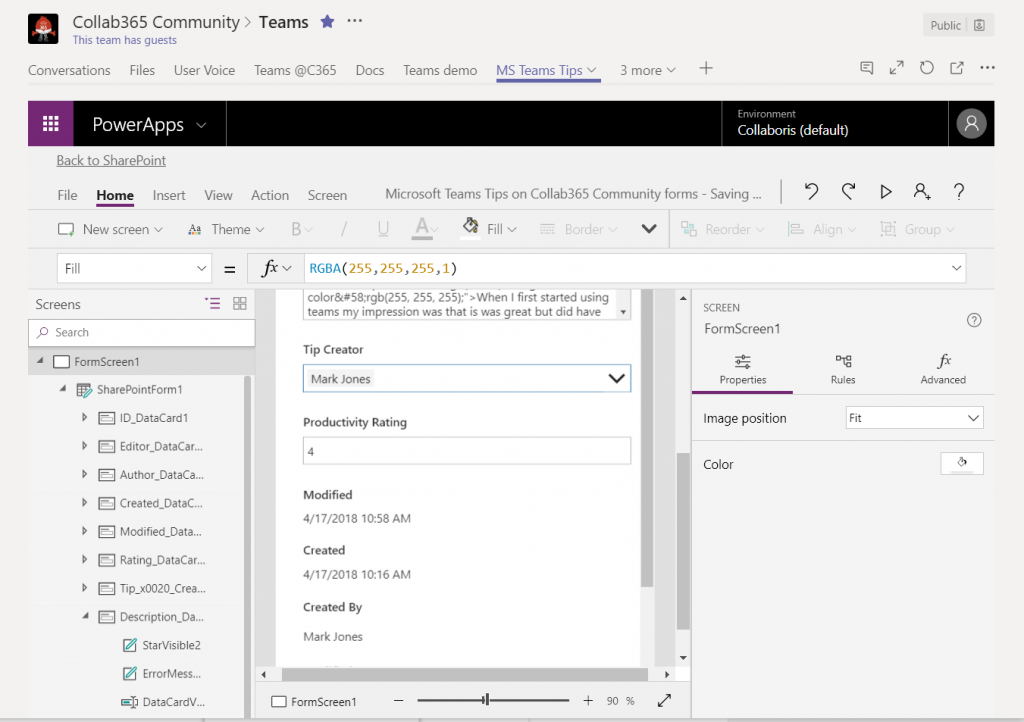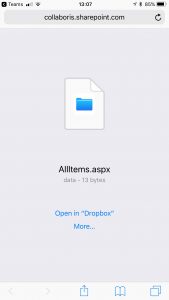A new ‘experience’ was added to Microsoft Teams which allows you to create a Teams Tab that surfaces a SharePoint list and it’s pretty nice.
We’ve been able to enjoy consuming document libraries via a Teams Tab (see “Files” tab) for ages and now we can do exactly the same with Lists. The best thing is, that it’s even better. You could also add any list to Teams via the “Website” Tab, but it’d show the entire page. Now all the chrome around the list is gone.
Take a look at this screenshot of a List shown in a Teams Tab:
You can see that Microsoft are now really reaping the rewards of introducing the ‘Modern look’ as it makes embedding SharePoint in other apps much easier. Instead of having lots of popups and a dated UI, we now have an elegant look with slide-ins, allowing it to feel native to Teams. Nice job.
BTW, we’ve also compiled a list of 13 Hacks to up your productivity with Teams.
An aside for Developers
I think most of these features are brought in as an Iframe (see below), so you’d expect it to function pretty much the same as SharePoint. However, notice all of the chrome (left nav, header, footer is gone). I imagine that there’s some ‘container sniffing’ going on as we also get the ability to “search” on the list tool bar which isn’t there in SharePoint.
The screenshot below shows that it’s brought in via an AngularJS “Webview” control. Maybe down the line when we get the new “SharePoint” tab this may change.
TIP: If you didn’t know Teams is actually largely put together using HTML within a desktop container. If you want to bring up the good old “Dev Tools” simply left click the Teams icon (in your Windows Tray) and then right click. This will bring up a menu that allows you to see what’s happening with the HTML and will allow you to see things like javascript errors. Kind of essential if you’re custom building a Teams Tab.
Mark Kashman introduces the new Teams / List experience below (about 18:50 in):
https://www.youtube.com/watch?time_continue=1502&v=7vj897RgWKQ
Anyway, the remainder of this blog outlines what works and what doesn’t when using a SharePoint List from within Teams.
Let’s get to it!
How to add a SharePoint List to a Teams Tab
In Mark Kashman’s demo he already had a list on Show and also alluded to the fact that a ‘SharePoint’ connector is going to drop into Teams, however, I was able to add the list simply by using the “Web site” url connector.
Here are the steps to add your List:
Beware of the classic UI!
Before we get started it’s important to note that the chrome will only be removed if your List is using the new Modern UI. If you are using Classic then you are going to see the entire List Items page within Teams, so you need to change it. It will work, but, it’s going to be an awful user experience as the menus will be shown in the relatively small area that Teams gives you.
In fact it will look like the image above. (Thanks to Martin Hamers for letting me try out guess access on his Tenant).
1. Create the list in the SharePoint site that backs your Team.
Firstly, you can’t create the List from Teams at the moment (and i don’t think you will ever be able to). However, once the List is created in SharePoint you can fully manage it. Let’s go to SharePoint and add a new List with the default “Title” column then add our extra columns in via the Teams UI.
>> See this in action in out community on Teams
Note: you need to add the List into the Team Site that Teams created for you when you set-up the Team. If you don’t know what this is, goto the “Files” tab and click “Open in SharePoint”.
2. Grab the Url of your list.
Once you’ve created the List you need to grab its Url and add it to your clipboard. We’re going to need it in the next step. In our example, the url is as follows:
https://xxxxx.sharepoint.com/sites/Collab365Community/Lists/Microsoft%20Teams%20Tips/AllItems.aspx
3. Navigate back to Teams, find the Channel and click ‘Add Tab’
Now let’s head back over Microsoft Teams. A Teams Tab is added at the Channel level so you will need to decide on the most appropriate Channel for your List. In our “Teams Community” we’ve got a Channel for discussion around Teams so I am going to add the “Teams Tips” List to a Tab on there.
Currently, there’s no “SharePoint” tab (but I think it’s coming). I expect this Tab will take your through a wizard so it’s easy to select your list. For now we’re going to add it as a normal “Website”.
Select the “Website” Tab and you will be confronted with this popup:
4. Now your Tab should look something like this.
You may be prompted to log-in with your Office 365 credentials here, but once you’ve done it your List will look like the screenshot below.
Here’s the low-down on the features when using from within Teams.
Add, edit and delete List Items
You can add by clicking the ‘+New’ menu item in the menu bar above the list. This will then ‘slide-in’ with the ‘New Item’ window. Depending on the field types you have in your list will depend on how you enter the data in this window:
A good example is that the title can be typed directly into that window however the Description field has a pencil edit option in order to update it. If you click this you will see the same popup as you are used to when using the SharePoint UI, so no changes there.
To edit or delete the list items, the behavior is much as it is in SharePoint. You can click the 3 dots against the list item for a menu of options, or you can simply select the item and use the menu items from the top menu….this shows both:
As well as edit and delete you can see all the other functionality in the same menu, some of which we will come onto later in this blog post
Filter your List
The Teams filter functionality is really easy and very similar to the normal SharePoint functionality. By clicking on the filter icon on the right. The columns with data types that can be filtered are shown for you to make your selection and view the data as you need to.
A really neat feature which will be of particular use when you have a large number of columns is being able to ‘Pin’ your most used/filtered on Columns to the top of this filter window just by clicking the 3 dots next to you chose field and click ‘Pin’.
Search within the List
Search shows the results in the pop-up but it doesn’t allow you to click on the item. (See note on Flow below. I think this must be to do with popup windows that can’t open up). Not working properly.
Sort the List by column
Next to each of the columns is an arrow to open up a menu that can give you access to various actions to carry out for that column, Including Sort Options, Filter, Group By, and Column Settings:
The sort options displayed will depend on the data type of the column, in this case it is a number so you can sort by size. The other great way to sort is to use the ‘Group by…’ option which will show the list in the Grouped headings that can be expanded and colapsed:
Get notifications from the List
As with normal SharePoint lists you can set up alerts against the lists so that you and/or your team can get notified when things are changed, added or removed from the list. You can set these up by clicking the 3 dots and selecting ‘Alert Me’.
The alert can then be configured as follows:
- Send Alerts to – Enter the emails of who the Alert goes to.
- Delivery Method – Email or SMS
- Change Type – Only Sent Alerts when:
- All Changes
- New Items are added
- Existing items are modified
- Items are deleted
- Send Alerts for These Changes:
- Anything changes
- Someone else changes an item
- Someone else changes an item Created by me
- Someone else changes an item last modified by me
- When to send alerts:
- Immediately
- Daily Summary
- Weekly Summary
More than one alert can be added in order to cover the various scenarios you may be interested in tracking.
Have a conversation around a List
Now this is new and COOL!
As with nearly everything in Teams you can have a conversation around a SharePoint List Tab. Imagine how cool it is to be able to collaborate around a list with your Team!
As with all teams conversations you can mention people or teams to alert them to the conversation, and the conversation will also show in your activity feed.
Create a PowerApp for the List
There are 2 PowerApps features you use directly from Teams.
- Add a new PowerApp
- Customise your List Forms
Now I wasn’t able get either working properly from directly within Teams. You can create the App but you can’t do anything with it. I will continue to play around and update this post if I find out why.
However, I was able to customise the list form with PowerApps within Teams. Here’s an example of a slightly modified form rendered entirely within Teams.
The problem with this approach is that when you try to create a new item from within Teams the PowerApps form never renders. You’d expect it to slide it in like it does in SharePoint but it doesn’t.
My advice for now, stay away from Teams PowerApps features as they need more work 🙂 Even if you create it all from SharePoint it doesn’t seem to work when within Teams.
Add a new Column to the List
As a nice to have, the engineers also allow you to add List columns to your List directly from withing Teams. You could have forgiven them if they’d not supplied this feature as it’s not too onerous to go back to SharePoint to do this. I think this gives a great indication of where Microsoft see Teams. Are we eventually going to be doing everything SharePoint related from within Teams? Is Teams eventually going to be come THE UI to get your work done across Office 365?
Anyway, back to the feature. To add a column you simply need to click on the “+” sgn and select the type you require.
You can see from the image below that you can create the entire column from within Teams never needing to navigate back to SharePoint.
It’s also worth noting that Teams will also honour your permissions so if you don’t have permission to create a list then you won’t be allowed to from Teams. You can start to see how native everything looks when used from within Teams – all thanks to the Modern UI.
Create a Flow around a List
As with PowerApps the Flow functionality doesn’t really work as it does from the SharePoint UI. I think this along with the PowerApps and Search features all suffer from the same issue. When they try to pop up a window (to the appropriate app) there’s no association, or it can’t derive the target url from within Teams.
Obviously, if you create the Flow from within SharePoint it will still work when you amend the list data.
Manage a view on the List
One essential feature that I am glad didn’t get cut out of the IFrame experience is for Views. Being able to to edit and choose which List View you’d like to show in your Teams Tab is pretty important. After all we’re limited on space and we may wish to show / hide certain columns and have default ordering and filtering (and so on).
What about Guest Access?
We’ve already had our guests insert new list items directly from within Teams, so yep all seems work out ok 🙂 Obviously, guests can’t carry out functions that they have no permissions to do.
Does this work in the mobile Teams App?
If you navigate to the Tab showing the List on mobile, clicking it just opens you in Safari and tries to download the AllItems.aspx page. So nope – it’s not working on mobile.
Closing thoughts …
All in all Microsoft have done well introducing the Modern UI as this has made it far easier to integrate Lists into Teams than if they tried to do it with Classic. Using Teams is nice in Lists but there are still some things that need to be worked on (such as making it easier to pick a list, getting it working on mobile etc.). Teams doesn’t really add anything extra on top of the normal SharePoint experience apart from being easier to find (as it’s in the app you’re using all day long). I imagine a lot of folks are going to use the conversation piece around a list so that’s a nice value add.

